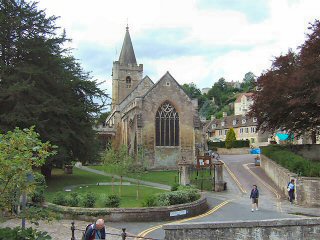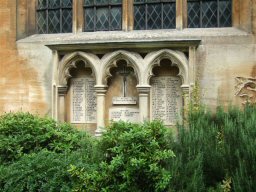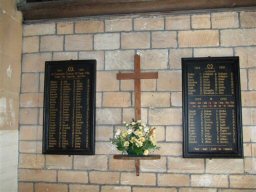RAY
WESTLAKE
At Holy Trinity Church, Bradford-on-Avon |
You know that you're going to like Bradford-on-Avon the moment you step out of the train - should you have been lucky enough to have travelled this way, and not by car - and onto the platform of its station. A station that, if you happen to look at an old print of it dated 1850, you will see has changed little. Bradford-on-Avon, where nothing offends the eye and where local stone was used to build cloth mills, fine old houses for those that owned them and cottages for the weavers that worked in them. Bradford-on-Avon, the town of strong, heavy front doors with polished brass knockers, hinges and letterboxes, and the home of Henry Shrapnel, inventor of the Shrapnel Shell. If you have a weak heart make the most of the level ground that takes your from the station, first to St Margaret Street and Westbury Gardens, then across the river to Holy Trinity Church. For everything after that is uphill. Steep, steep, climbs that take you by road, lane or narrow passageway up to the houses that have looked down on the town for centuries.

If we return now for the moment to Westbury Gardens, where in 1791 a mob protested against machinery introduced into the mill owned by the man then living in the adjacent house (later Westbury House), we will find here the town war memorial.

Unveiled (and 'handed over' to Bradford-on-Avon Urban District Council, according to an inscription) on 2nd August 1922 by Walter Hume Long, 1st Viscount Long of Wraxall (1854-1924) and standing here tall and strong still. Here on two bronze tablets are the names of those that fell in the Great War. One hundred and twenty-five of them arranged alphabetically (Adams C.E to White W.) without rank or regiment.
With, no doubt, a strong heart, Canon Jones (Vicar of Holy Trinity and a keen historian) having climbed the hill in 1857 so as to look down on his church, noticed that the roofs of the buildings next door seemed to suggest an outline of a smaller church. Back home he consulted his reference books and found that indeed a church had existed on this site. But here still hidden among a series of later building added on. It took twelve years, but much hard work was to rescue from a mass of brickwork St Laurence's, now considered to be the finest Saxon church in the country.
| Next door, on the south side of Holy Trinity, is the second town memorial of the day. Just one hundred names this time which are shown on two stone panels within a canopied niche. On a third, and smaller tablet, are a further seven names, which seem to have arrived as an afterthought to the main listing. Even though no less than six of the additional names appear on the Westbury Gardens memorial of 1922. Why, and this is a question not unfamiliar to the war memorial researcher, the variation in name totals? |  |
 |
But the mystery does not end outside Holy Trinity at its south wall - which, incidentally opens, should you visit on a Saturday, at 2 pm. We enter the south porch and there on the east wall is another set of names. Two wood panels (black, the lettering in gold) and this time with just one hundred and two names. Again, and for the second time today, the same question is asked. Why the variation in totals? |
Holy Trinity, Bradford-on-Avon, falls into the 'high, wide and handsome', category of churches. For across the road from Saxon England is a church began by the Normans where just inside in the west wall is the tomb of William Baily who has been here, with his cross-bones and skulls, since Queen Anne was on the throne. All around are monuments. Many of them to former mill owners and the occupants of the fine houses that we see climbing the steep hills around Bradford. One man served as a Colonel in the 14th Foot and there, on the south wall, is a brass to those that lost their lives in South Africa and the Boer War of 1899-1902.
 |
But of interest to us is the narrow window on the north side of
the chancel. It's by H.W. Bryans (1921) who's work you can also see, should
you be in Oxfordshire, at Clifton Hampden (St Michael's and All Angels) or
Holwell (St Mary's). Nineteen-year-old Reginald John Yerbury who on 30th
September 1916 died in hospital at Etaples, France from wounds received at
the Battle of the Somme. And as ever, 'died of wounds' in a hospital far
from the battlefield leaves the researcher unsure as to where and when the
fatal injuries were received.
So we must now turn to the Battalion War Diary, which in this case is that of the 1/8th Middlesex Regiment. Safe, shall we say, to begin on the 4th September 1916 when on that day the 1/8th entrained at St Riquier for Corbie and from there marched to Bois des Tallies close to the front line. Duty in the forward trenches about Leuze Wood began on the 10th, two companies attacked the German line on the Ginchy-Morval road at midnight 11th, and their subsequent gains were held - despite strong counter attacks. |
The casualties here amounted to one hundred and sixty-five. The next attack was on the 15th. This time the 1/8th Middlesex moving forward to Leuze Wood and assaulting the enemy down the north-west side of Bouleaux Wood at 1.40 pm. The cost this time would be two hundred and forty-five killed, wounded or missing. But just as likely as it was to be fatally wounded in a direct attack, was injury during normal trench warfare and periods out of the front line. The period now leading up to 30th September seeing the Middlesex occupying positions at Casement Trench, Angle Wood, German Wood, the village of Morlancourt and the reserve line at Flers.
But if the quandary as to how three memorials in the same town can have three different name totals is not enough, we are now faced with the problem of just how 3345, Lance-Corporal Reginald John Yerbury fits into it all. For we will not see his name in raised bronze letters back at Westbury Gardens, neither will it be seen on the stone panels on the south side of this church, or in wood within its porch. Yet again, one of the everyday mysteries that are the war memorial researcher's lot.
Well, Reg Yerbury - although his relatives have a pedigree connected to Bradford-on-Avon going back centuries, relatives that saw fit to commemorate him in their town - was a Trowbridge man. Born there (so says that most valuable of documents Soldiers Died in the Great War) but enlisted into the Army at Ealing. Just there to the west of London and since 1908 the Headquarters of 'F' Company, 8th Battalion, Middlesex Regiment (Territorial Force).
![]()
 Copyright © Ray
Westlake August, 2006
Copyright © Ray
Westlake August, 2006
Return to the War Memorials Contents Page
Return to the Hellfire Corner Contents Section